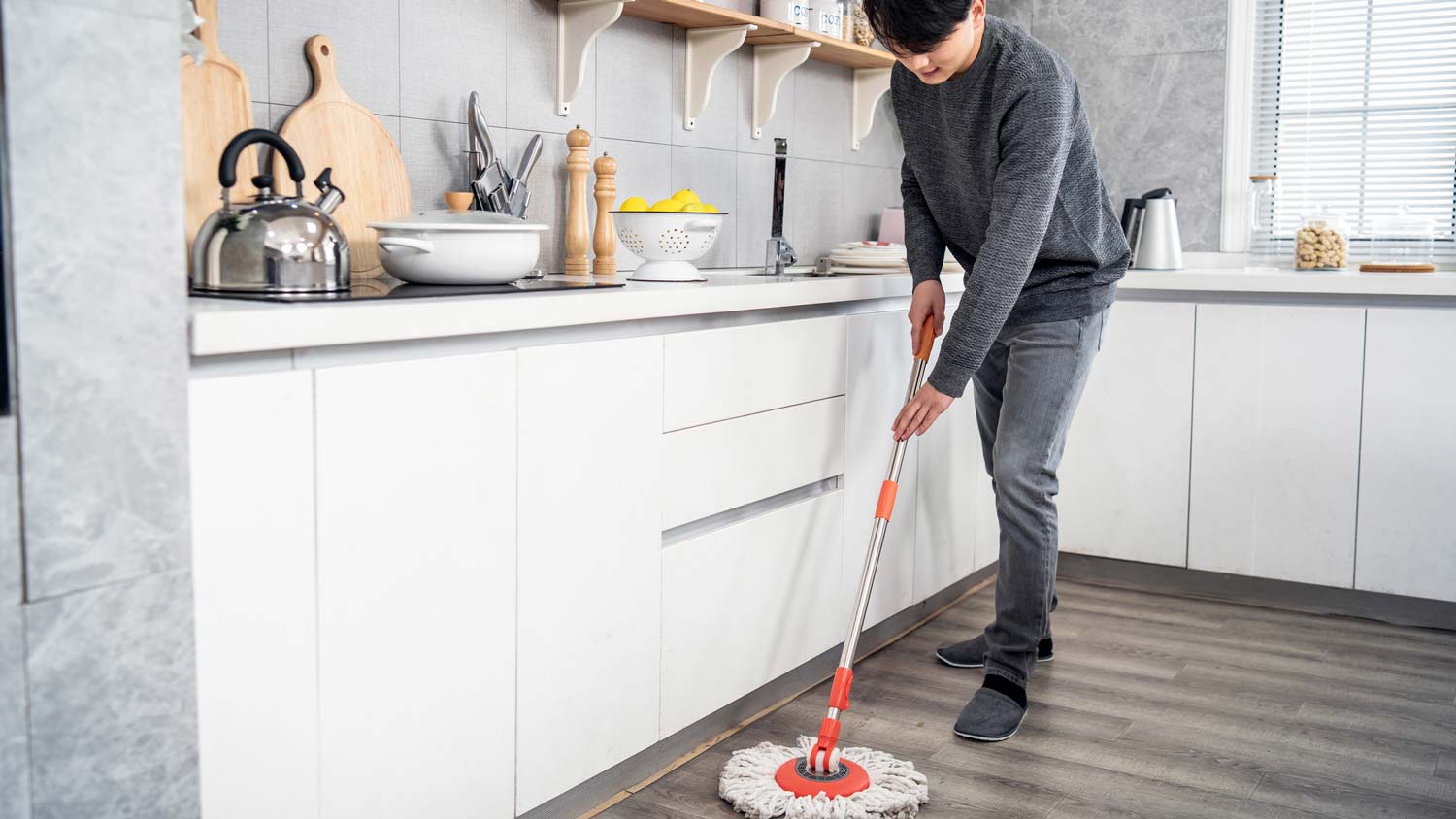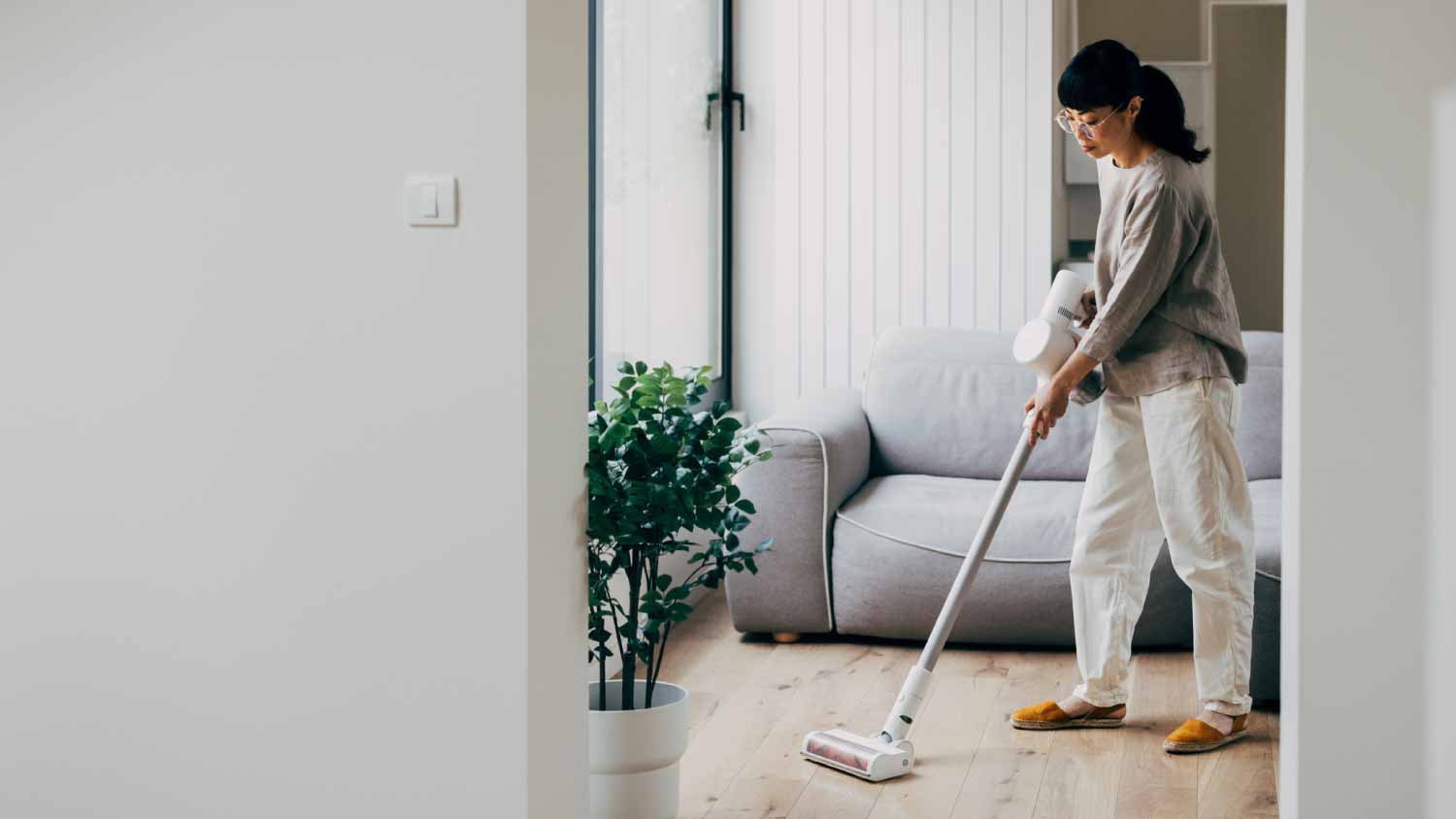
Clean walls are an important part of a well-kept house. Use this wall cleaning cost guide to see what it would cost to hire a professional to get the job done.
Give your room a total refresh


Whether you want to brighten your space, remove scuffs and smudges, or prep for painting, washing your walls is a simple DIY project. However, you’ll want to use safe products and cleaning techniques that won’t damage your paint finish. We’ll teach you what to wash your walls with and break down how to clean walls, no matter the surface.
Before you start the actual cleaning process, be aware that not all cleaning methods are suitable for all types of walls and interior paint. Here, we’ve pulled together some cleaning guidelines for the most common types of walls and paint finishes:
Drywall with eggshell or satin paint: Use moderate scrubbing; most cleaners will work
Drywall with flat paint: Limit scrubbing and harsh wall cleaners
Drywall with high-gloss paint: Use moderate scrubbing; most cleaners will work
Wood walls or paneling: Heavy scrubbing is acceptable; use an all-natural cleaner or oil soap
Brick walls: Heavy scrubbing is acceptable; a bleach solution can be used to remove stains

With a long-handled duster or microfiber cloth, dust the entire surface of the wall from the ceiling to the floor, horizontally from left to right. Make sure you reach the corners. For larger dust bunnies and abandoned spiderwebs, use a handheld vacuum or one with a brush and hose attachment. A vacuum also works best on textured walls and those made of brick because it reaches all angles.
Dusting the walls before washing them down is imperative. "By removing dust, debris, and hair prior to washing the walls, you are saving yourself time, energy, and frustration,” says Asya Biddle, Angi Expert Review Board member and manager of The Dustbusters, a family-owned and operated janitorial company in Williamsport, PA. “If you skip this step, it will take much longer, and you will find that some of the dust and hair will be left on the walls when dried and in your cleaning cloth."
Next, mix your cleaning solution, or get your premixed solution ready. You can use the following recipes to get the right solution for your wall.
1 tablespoon of bleach in 1 gallon of warm water
1/2 cup of vinegar in 2 cups of warm water (a few drops of dish soap optional)
1/2 cup of vinegar in 2 cups of warm water
Same as eggshell paint, or a commercial wall cleaner
Same as eggshell paint, or an all-natural commercial wall cleaner

Soak your cleaning cloth or sponge in your cleaning solution (see the table above to find the right solution for your wall type). Wring out excess water and cleaner from the cloth.
The best way to clean walls is to scrub gently in circular motions from top to bottom, left to right. Use gentle pressure. More aggressive washing can damage the paint or other surface, especially if you have flat paint. You can also clean your ceilings using the same method.
Heavier scrubbing on wood or brick walls shouldn’t damage the surface. Avoid soaking the wall, as it could cause the paint or wallpaper to bubble or leave watermarks.
You should also gently wipe down your door and window trim, light switches, outlets, and thermostats with a lightly damp cloth. Avoid soaking these areas, as this could pose an electrical risk.
Next, you should plan to spot-clean any stubborn stains or particularly soiled areas of the wall. Your cleaning will depend on the type of issue you’re dealing with.
To tackle stains on your walls, you’ll need to spot-clean them a little more aggressively, depending on how deep the stain is. First, sprinkle baking soda on a damp cloth and gently scrub the stain. Then, rinse the wall area with a clean damp cloth. If that doesn’t work, try using a cleaning eraser, but be sure to test it on an inconspicuous area first and read the manufacturer's instructions. Cleaning erasers are not recommended on high gloss, satin, and clear coat paints, wallpaper, or wood, as they could leave a permanent mark.
If you have a water stain, repainting is often the best way to take care of the discoloration. But first, be sure to fix the leak or underlying issue so water doesn't stain your walls again. If you notice during cleaning that the stain is actually mold on your walls, you can use a diluted bleach solution to scrub the wall gently. This will likely damage the wall, but it might be necessary to remove spores before repainting.
Minor scuffs and other marks on your walls should require less intense cleaning. For these, you can try putting some baking soda on a damp cloth, and use a gentle circular motion to buff out the scuff. This should do the trick for most minor marks on your walls.
After you’re done washing the walls, dump your bucket out and fill it with clean, warm water. Then, dip a clean cloth in the water and wring it out. Wipe down the entire wall surface to get rid of leftover dirt and detergents, rinsing off the cloth as needed. If you have wood walls, skip the rinse.
Use a towel or microfiber cloth to absorb any leftover moisture on the walls. If it’s a warm, dry day, open your windows and let the breeze speed up the drying process.

If you have discoloration or stains that won't go away, consider touching up the area with the same color and paint finish. Be sure to protect your floors from any paint drips or spills. Gently brush or roll off any excess paint on your roller or paintbrush before using light, feather-like strokes over the stain.
Once your walls have been cleaned, you can keep them that way for longer by following a few key tips:
Clean spills, scuffs, smudges, crayon marks, and other blemishes as soon as they happen. This step makes them easier to clean off of the surface of your wall.
Dust your walls and clear away cobwebs at least a few times a year, especially if you have textured walls.
Avoid smoking in the house to prevent soot on your walls.
If you use a wood fireplace in your home often, consider doing touch-up cleanings a few times per year to remove any soot from your walls.
Stick to satin and eggshell paint finishes on most walls for easier clean-up.
Opt for gloss or semi-gloss paint finishes in the kitchen so it’s easier to remove grease.
Clean high-traffic areas regularly, such as the walls in your dining room or living room.
Do your best to avoid touching the walls, as hands can leave behind oils and dirt.
When it comes to home improvement projects, cleaning your walls is one of the easiest projects you can tackle, so we recommend doing this yourself. It’s pretty difficult to mess up, provided you follow the guide above and use the appropriate cleaning solution for your wall and paint type. Plus, the cost to clean walls as a DIYer is minimal.
However, if you have excessive mold or heavy stains on your walls, we recommend calling in a professional. The pro might be able to identify the underlying issue and fix it, and they have tools and supplies that can provide a deeper cleaning for heavy soiling.
Even if you’re not dealing with mold or heavy stains, though, the job takes time, and if you’re working with a lot of square footage or have walls with tall ceilings that require ladders or scaffolding to clean—especially over staircases and kitchen cabinets—you may want to call a pro. You can hire a house cleaner near you to get the job done quickly and correctly. House cleaning costs between $30 and $50 per hour, in most cases.
Jenna Jonaitis contributed to this piece.
From average costs to expert advice, get all the answers you need to get your job done.

Clean walls are an important part of a well-kept house. Use this wall cleaning cost guide to see what it would cost to hire a professional to get the job done.

Keeping your home clean is good for you and your house. Learn what deep cleaning is and how it differs from regular cleaning before you whip out the sponges.

Construction leaves dust and debris in its wake. If you hire a pro to handle it, here are the post-construction cleanup questions you should be ready to answer.

A home maintenance checklist can help you keep on top of necessary tasks and repairs. Learn how to keep your house in good condition and avoid costly problems.

How often should you deep clean your house? Learn what timing factors to consider before deep cleaning your home.

Learn how to prepare for a house cleaner to ensure whoever you hire can do their job properly while you keep your home, family, and possessions safe.